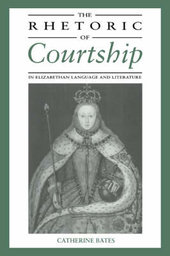
|
The Rhetoric of Courtship in Elizabethan Language and Literature
Hardback
Main Details
| Title |
The Rhetoric of Courtship in Elizabethan Language and Literature
|
| Authors and Contributors |
By (author) Catherine Bates
|
| Physical Properties |
| Format:Hardback | | Pages:252 | | Dimensions(mm): Height 236,Width 158 |
|
| Category/Genre | Semantics
Literary studies - c 1500 to c 1800 |
|---|
| ISBN/Barcode |
9780521414807
|
| Classifications | Dewey:820.9353 |
|---|
| Audience | | Professional & Vocational | | Tertiary Education (US: College) | |
|---|
|
Publishing Details |
| Publisher |
Cambridge University Press
|
| Imprint |
Cambridge University Press
|
| Publication Date |
18 June 1992 |
| Publication Country |
United Kingdom
|
Description
In the sixteenth century the modern meaning of courtship - 'wooing someone' - developed from an older sense - 'being at court'. The Rhetoric of Courtship takes this semantic shift as the starting point for an incisive account of the practice and meanings of courtship at the court of Elizabeth I, where 'being at court' pre-eminently came to mean the same as 'wooing' the Queen. Exploring the wider context of social anthropology, philology, cultural and literary history, Catherine Bates presents courtship as a judicious, sensitive and rhetorically conscious understanding of public and private relations. Gascoigne, Lyly, Sidney, Leicester, Essex, and Spenser are shown to reflect in the fictional courtships of their poetry and prose the vulnerabilities of court life that were created by the system of patronage. The Rhetoric of Courtship thus makes an important contribution to Renaissance cultural history, using the court of Elizabeth I as a test case for representations of the courtier's role and power in the literature of the period.In the sixteenth century the modern meaning of courtship - 'wooing someone' - developed from an older sense - 'being at court'. The Rhetoric of Courtship takes this semantic shift as the starting point for an incisive account of the practice and meanings of courtship at the court of Elizabeth I, where 'being at court' pre-eminently came to mean the same as 'wooing' the Queen. Exploring the wider context of social anthropology, philology, cultural and literary history, Catherine Bates presents courtship as a judicious, sensitive and rhetorically conscious understanding of public and private relations. Gascoigne, Lyly, Sidney, Leicester, Essex, and Spenser are shown to reflect in the fictional courtships of their poetry and prose the vulnerabilities of court life that were created by the system of patronage. The Rhetoric of Courtship thus makes an important contribution to Renaissance cultural history, using the court of Elizabeth I as a test case for representations of the courtier's role and power in the literature of the period.
|